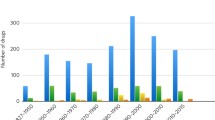Abstract
G-protein coupled receptors (GPCRs) are promising targets for the discovery of novel drugs. In order to identify novel chemical series, high-throughput screening (HTS) is often complemented by rational chemogenomics lead finding approaches. We have compiled a GPCR directed screening set by ligand-based virtual screening of our corporate compound database. This set of compounds is supplemented with novel libraries synthesized around proprietary scaffolds. These target-directed libraries are designed using the knowledge of privileged fragments and pharmacophores to address specific GPCR subfamilies (e. g., purinergic or chemokine-binding GPCRs). Experimental testing of the GPCR collection has provided novel chemical series for several GPCR targets including the adenosine A1, the P2Y12, and the chemokine CCR1 receptor. In addition, GPCR sequence motifs linked to the recognition of GPCR ligands (termed chemoprints) are identified using homology modeling, molecular docking, and experimental profiling. These chemoprints can support the design and synthesis of compound libraries tailor-made for a novel GPCR target.
Access this chapter
Tax calculation will be finalised at checkout
Purchases are for personal use only
Preview
Unable to display preview. Download preview PDF.
Similar content being viewed by others
References
Ballesteros JA, Weinstein H (1995) Integrated methods for the construction of three-dimensional models and computational probing of structure-function relations of G protein-coupled receptors. Meth Neurosci 25:366–428
Bondensgaard K, Ankersen M, Thogersen H, Hansen BS, Wulff BS, Bywater RP (2004) Recognition of privileged structures by G-protein coupled receptors. J Med Chem 47:888–899
Bredel M, Jacoby E (2004) Chemogenomics: an emerging strategy for rapid target and drug discovery. Nat Rev Genet 5:262–275
Caron PR, Mullican MD, Mashal RD, Wilson KP, Su MS, Murcko MA (2001) Chemogenomic approaches to drug discovery. Curr Opin Chem Biol 5:464–470
Evers A, Klabunde T (2005) Structure-based drug discovery using GPCR homology modeling: successful virtual screening for antagonists of the alpha1A receptor. J Med Chem 28:1088–1097
Fredholm, BB (2003) Adenosine receptors as targets for drug development. Drug News Perspect 16:283–289
Jacoby E, Fauchère J-L, Raimbaud E, Ollivier S, Michel A, Spedding M (1999) A three binding site hypothesis for the interaction of ligands with monoamine G protein-coupled receptors: implications for combinatorial ligand design. Quant Struct-Act Relat 18:561–571
Jimonet P, Jäger R (2004) Strategies for designing GPCR-focused libraries and screening sets. Curr Opin Drug Discov Devel 7:325–333
Klabunde T, Hessler G (2002) Drug design strategies for targeting G-protein-coupled receptors. Chembiochem 3:928–944
Kubinyi H, Müller G (2004) Chemogenomics in drug discovery. Wiley-VCH, Weinheim
Lewell XQ, Judd DB, Watson SP, Hann MM (1998) RECAP — retrosynthetic combinatorial analysis procedure: a powerful new technique for identifying privileged molecular fragments with useful applications in combinatorial chemistry. J Chem Inf Comput Sci 38:511–522
Shi L, Javitch JA (2002) The binding site of aminergic G Protein-coupled receptors: the transmembrane segments and second extracellular loop. Annu Rev Pharmacol Toxicol 42:437–467
Venter JC, Adams MD, Myers EW et al (2001) The sequence of the human genome. Science 291:1304–1351
Wise A, Gearing K, Rees S (2002) Target validation of G-protein coupled receptors. Drug Discov Today 7:235–246
Author information
Authors and Affiliations
Editor information
Editors and Affiliations
Rights and permissions
Copyright information
© 2006 Springer-Verlag Berlin Heidelberg
About this paper
Cite this paper
Klabunde, T., Jäger, R. (2006). Chemogenomics Approaches to G-Protein Coupled Receptor Lead Finding. In: Jaroch, S., Weinmann, H. (eds) Chemical Genomics. Ernst Schering Research Foundation Workshop, vol 58. Springer, Berlin, Heidelberg. https://doi.org/10.1007/978-3-540-37635-4_3
Download citation
DOI: https://doi.org/10.1007/978-3-540-37635-4_3
Publisher Name: Springer, Berlin, Heidelberg
Print ISBN: 978-3-540-27865-8
Online ISBN: 978-3-540-37635-4
eBook Packages: Chemistry and Materials ScienceChemistry and Material Science (R0)




